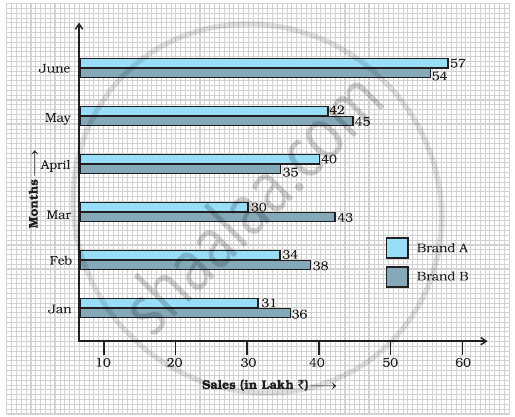Advertisements
Advertisements
Question
In a public library, the following observations were recorded by the librarian in a particular week:
| Days | Mon | Tues | Wed | Thurs | Fri | Sat |
| Newspaper Readers |
400 | 600 | 350 | 550 | 500 | 350 |
| Magazines Readers |
150 | 100 | 200 | 300 | 250 | 200 |
- Draw a double bar graph choosing an appropriate scale.
- On which day, the number of readers in the library was maximum?
- What is the mean number of magazine readers?
Solution
a. Steps to construct the bar graphs are as follows:
Step I: We draw two lines perpendicular to each other on graph paper and call them horizontal and vertical axes.
Step II: Along the horizontal axis, we mark the days and along the vertical axis, we mark the readers.
Step III: We choose a suitable scale to determine the heights of bars. Here, we choose the scale as 1 small division to represent 50.
Step IV: First, we draw the bars for newspaper readers and then bars for magazine readers for different days.
Bars for newspapers and magazine readers are shaded separately and the shading is shown in the top right corner of the graph paper.

b. Total number of both readers in different days are
| Day | Readers |
| Mon | 400 + 150 = 550 |
| Tue | 600 + 100 = 700 |
| Wed | 350 + 200 = 550 |
| Thur | 550 + 300 = 850 |
| Fri | 500 + 250 = 750 |
| Sat | 350 + 200 = 550 |
Hence, it is clear that the number of readers was maximum on Thursday.
c. Mean of readers = `"Sum of all the magazine readers on six days"/6`
= `(150 + 100 + 200 + 300 + 250 + 200)/6`
= `1200/6`
= 200
APPEARS IN
RELATED QUESTIONS
Use the bar graph (see the given figure) to answer the following question.

Which is the most popular pet?
The following table shows the number of Buses and Trucks in nearest lakh units. Draw percentage bar-diagram. (Approximate the percentages to the nearest integer)
| Year | No of trucks | No of buses |
| 2005-2006 2007-2008 2008-2009 2009-2010 |
47 56 60 63 |
9 13 16 18 |
Bar diagram of first term scores of a student are given.
a. The highest score is in _________.
b. The lowest score is in _________.
c. The same scores are in _________ and _________.
Comparison of parts of a whole may be done by a ______.
The graph shows the maximum temperatures recorded for two consecutive weeks of a town. Study the graph and answer the questions that follow.

- What information is given by the two axes?
- In which week was the temperature higher on most of the days?
- On which day was the temperature same in both the weeks?
- On which day was the difference in temperatures the maximum for both the weeks?
- What were the temperatures for both the weeks on Thursday?
- On which day was the temperature 35°C for the first week?
- On which day was the temperature highest for the second week?
In a bar graph, the gap between two consecutive bars may not be the same.
Read the bar graph given below and answer the following questions:
Scale: 1 unit = 50 students
(a) What information is given by the bar graph?
(b) In which year is the number of students maximum?
(c) In which year is the number of students twice as that of 2001 – 02?
(d) In which year did the number of students decrease as compared to previous year?
(e) In which year is the increase in number of students maximum as compared to the previous year?
The bar graph given below shows the marks of students of a class in a particular subject:

Study the bar graph and answer the following questions:
- If 40 is the pass mark, then how many students have failed?
- How many students got marks from 50 to 69?
- How many students scored 90 marks and above?
- If students who scored marks above 80 are given merits then how many merit holders are there?
- What is the strength of the class?
Study the double bar graph shown below and answer the questions that follow:

- What information is represented by the above double bar graph?
- In which month sales of Brand A decreased as compared to the previous month?
- What is the difference in sales of both the Brands for the month of June?
- Find the average sales of Brand B for the six months.
- List all months for which the sales of Brand B was less than that of Brand A.
- Find the ratio of sales of Brand A as compared to Brand B for the month of January.
The following table shows the average intake of nutrients in calories by rural and urban groups in a particular year. Using a suitable scale for the given data, draw a double bar graph to compare the data.
| Foodstuff | Rural | Urban |
| Pulses | 35 | 49 |
| Leafy vegetables | 14 | 21 |
| Other vegetables | 51 | 89 |
| Fruits | 35 | 66 |
| Milk | 70 | 250 |
| Fish and flesh floods | 10 | 22 |
| Fats and Oils | 9 | 35 |
| Sugar/Jaggery | 19 | 31 |
